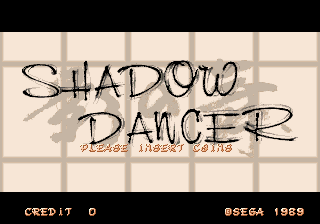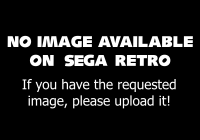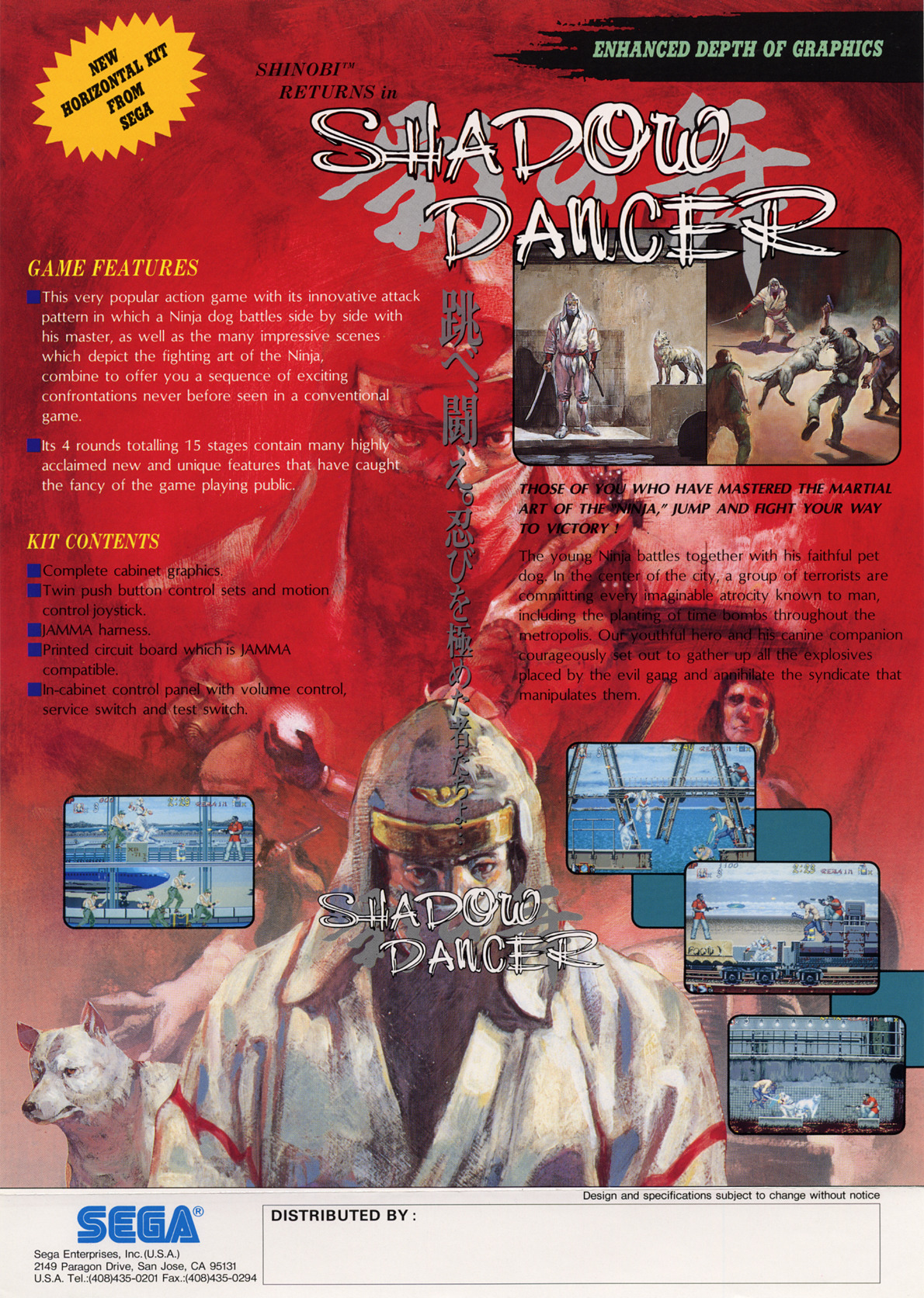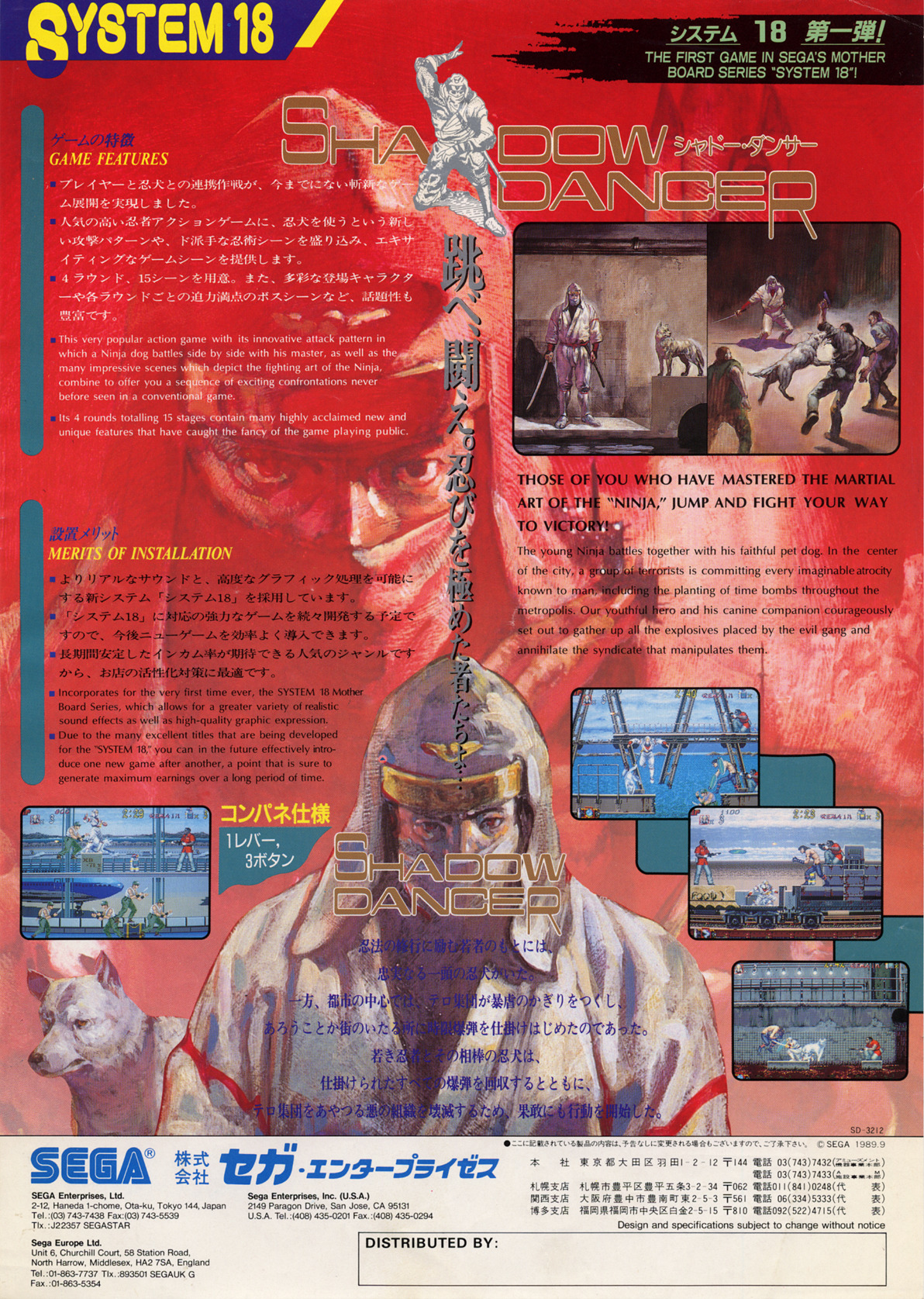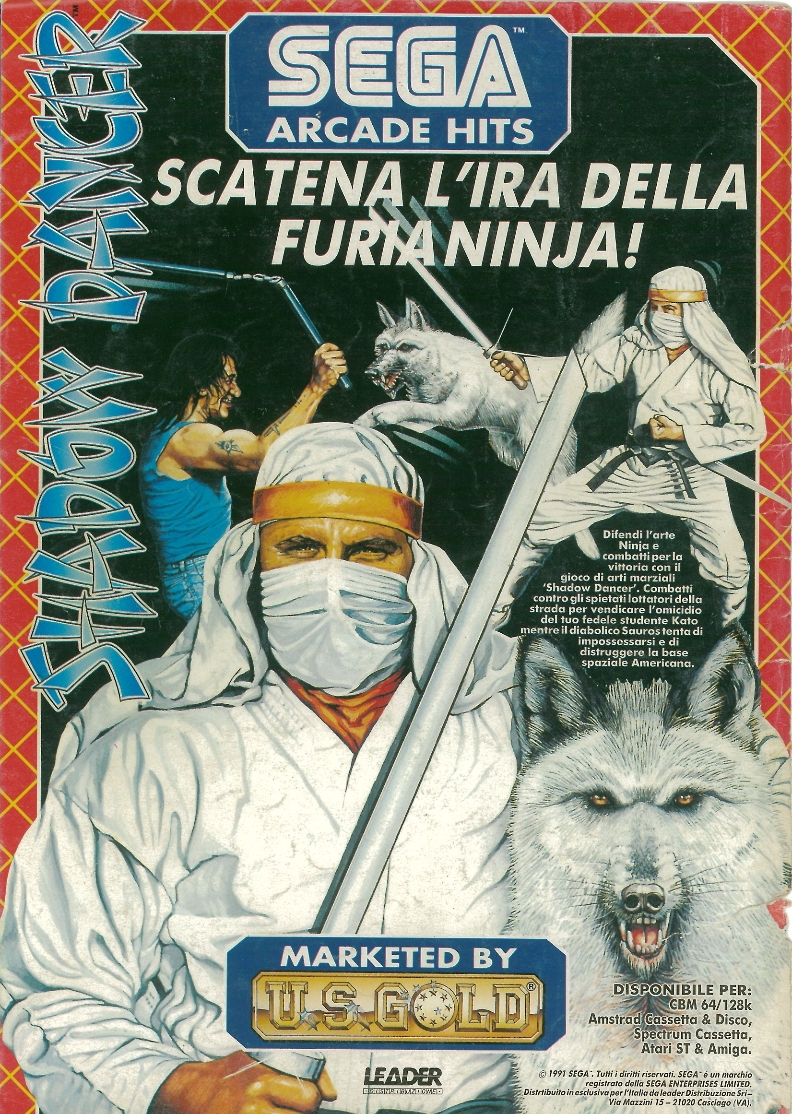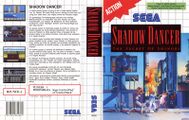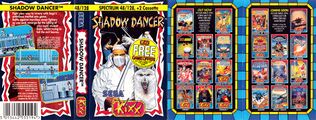Difference between revisions of "Shadow Dancer"
From Sega Retro
| Line 265: | Line 265: | ||
===Amstrad CPC version=== | ===Amstrad CPC version=== | ||
| − | {{ratings | + | {{ratings|CPC}} |
| − | | | ||
| − | |||
| − | |||
| − | }} | ||
{{Scanbox | {{Scanbox | ||
| console=Amstrad CPC | | console=Amstrad CPC | ||
| Line 293: | Line 289: | ||
===Atari ST version=== | ===Atari ST version=== | ||
| − | {{ratings | + | {{ratings|CPC}} |
| − | | | ||
| − | |||
| − | |||
| − | }} | ||
{{Scanbox | {{Scanbox | ||
| console=Atari ST | | console=Atari ST | ||
Revision as of 13:35, 16 June 2020
- For the Sega Mega Drive game, see Shadow Dancer: The Secret of Shinobi.
| Shadow Dancer | |||||||||||||||||||||||||||||||||||||||||||||||||||||||||||||||||||||||||||||||||||||||||||||||||||||||
|---|---|---|---|---|---|---|---|---|---|---|---|---|---|---|---|---|---|---|---|---|---|---|---|---|---|---|---|---|---|---|---|---|---|---|---|---|---|---|---|---|---|---|---|---|---|---|---|---|---|---|---|---|---|---|---|---|---|---|---|---|---|---|---|---|---|---|---|---|---|---|---|---|---|---|---|---|---|---|---|---|---|---|---|---|---|---|---|---|---|---|---|---|---|---|---|---|---|---|---|---|---|---|---|
| System(s): Sega System 18, Sega Master System, Amiga, Atari ST, Amstrad CPC, Commodore 64, ZX Spectrum | |||||||||||||||||||||||||||||||||||||||||||||||||||||||||||||||||||||||||||||||||||||||||||||||||||||||
| Publisher: Sega U.S. Gold | |||||||||||||||||||||||||||||||||||||||||||||||||||||||||||||||||||||||||||||||||||||||||||||||||||||||
| Developer: Sega R&D 1 Images[1][2] | |||||||||||||||||||||||||||||||||||||||||||||||||||||||||||||||||||||||||||||||||||||||||||||||||||||||
| Genre: Action | |||||||||||||||||||||||||||||||||||||||||||||||||||||||||||||||||||||||||||||||||||||||||||||||||||||||
| Number of players: 1 | |||||||||||||||||||||||||||||||||||||||||||||||||||||||||||||||||||||||||||||||||||||||||||||||||||||||
|
Shadow Dancer (シャドー・ダンサー), known as Shadow Dancer: The Secret of Shinobi on Master System covers, is an action platform game developed by Sega for the Sega System 18 arcade system in 1989. A port of the game was published by Sega for the Sega Master System, and ports to several home computers were published by U.S. Gold. Alongside The Revenge of Shinobi, this game was the first sequel to Shinobi.
A similar game titled Shadow Dancer: The Secret of Shinobi was released for the Sega Mega Drive, which features an entirely different set of levels.
Contents
Story
| “ | 忍法の修行に励む若者のもとには、忠実なる一頭の忍犬がいた。 一方、都市の中心では、テロ集団が暴虐の限りをつくし、 あろうことか街のいたる所に時限爆弾を仕掛け始めたのであった。 若き忍者とその相棒の忍犬は、仕掛けられたすべての爆弾を回収するとともに、テロ集団をあやつる悪の組織を壊滅するため、果敢にも行動を開始した。 | „ |
| “ | The young Ninja battles together with his faithful pet dog. In the center of the city, a group of terrorists are committing known to man, including the planting of time bombs throughout the metropolis. Our youthful hero and his canine companion courageously set out to gather all the explosives placed by the evil gang and annihilate the syndicate that manipulates them. | „ |
In the Master System version, main character is named Takeshi in manual and Fuma in the attract sequence (no relationship to Joe Musashi is mentioned in either case) and tasked with preventing a terrorist organization (named "Asian Dawn" in the manual) from taking control of an orbital space weapon system.
At the time of release, Shadow Dancer was not strictly affiliated with Shinobi in terms of plot, though the set-up is very similar to the original arcade game. The naming of the characters varies between home versions of the game, as do their motives.
Gameplay
Shadow Dancer expands on the gameplay seen in Shinobi, being a side-scrolling action game inspired by the likes of Namco's Rolling Thunder. The original game's moveset remains in-tact, however rather than saving children, the task is to defuse bombs. All bombs in the level must be defused to get to the next level.
Players' main method of attack is throwing shurikens. If too close to the enemy, player will either slash the enemy with sword or kick or punch them. Touching an enemy who is not attacking will push the player back. Certain defused bombs will turn shurikens to burning shurikens, causing double damage.
There is no energy level and player will lose a life is he is hit by enemy projectiles or melee attacks and will be forced to start the level from the beginning.
Most notably, Shadow Dancer adds an AI-controlled white dog (named "Yamato") which can be used to take down enemies. By crouching, dog will start barking and by pressing the attack button, dog will attack the nearest enemy and hold him until player can kill the target. However, if player takes too long, enemy will simply push back the dog. If damaged, dog will shrink and won't be able to assist the player until he grows back to normal size. Certain enemies, such as guys with green shields and ninjas armed with swords are immune to dog attacks.
Player can use ninja magic during battle which will kill all regular enemies or seriously damage the boss. Player can use Tatsumaki (Whirlwind), Fire Dog or Butsuzo (Buddha) magic. Beside the different attack animation, all magic cause same damage. Game randomly assigns a magic to player at the beginning of each level.
Gameplay
Missions
Versions
Master System version
Shadow Dancer on the Master System retains a lot of the arcade game's content, but simplifies the graphics and sound to better suit the hardware. Level layouts are slightly different, and the decision to use sprites similar in size to the arcade version means that fewer enemies can appear on screen at any one time. Sprite flicker is a common sight, and entire sections of levels are removed to save space. Unlike the arcade version, players cannot backtrack during either side scrolling or boss sections, limiting player to a very small section of the screen during the boss fights.
The most striking omission in the Master System version of Shadow Dancer is the dog as an active character, but it is still available as a game mechanic. When a valid target is onscreen, the player must crouch. While crouched, the ninja magic icon will slowly transform into a a dog head. When the icon is completely full, it will move to the target enemy's location. Pressing attack will cause the dog to appear out of nowhere and attack the enemy. If no valid target exists, the icon will not move and pressing attack while crouched will perform a normal attack. Dog can be called only three times each level.
Master System version retains the first person shuriken throwing bonus rounds but the one between the second and third level is the same bonus round used by the Mega Drive version, which makes player to jump from a tall building and attack ninjas in a downward shoot 'em up fashion.
Just like the Master System version of Shinobi, Ninja magic cannot be used during boss fights. In addition to the previously mentioned problem of being confined to the small section of the screen makes the boss fights even more difficult than the arcade version.
A small oddity, in the Master System version, player always bows to boss before the boss battle.
Amstrad CPC and ZX Spectrum versions
The Amstrad CPC and ZX Spectrum versions of Shadow Dancer share similar cutbacks and are likely based on the same code. Both versions opt for a more zoomed-in look than is perhaps ideal, introducing extra vertical scrolling. Music is nonexistent (save for the title screen if running on a 128kB Spectrum) and sound effects are limited. Both also omit some backgrounds, presumably to save space.
The Amstrad uses more colours but the Spectrum runs in a higher screen resolution.
Commodore 64 version
On the Commodore 64, Shadow Dancer has no in-game music. While the backgrounds are simplified considerably on the C64, an attempt was made to retain the parallax scrolling, which is missing in most home versions of the game.
Amiga and Atari ST versions
Climax ( under the name of Images Software Ltd[2][9]) created the Amiga and Atari ST versions simultaneously, targeting the ST first and then porting the game's contents to the Amiga, where minor improvements would be added[10]. Sega did not give the team access to the game's source code, so sprites were copied from a video of the game and touched up in the Atari ST version of OCP Art Studio[10].
As was to be expected, the two versions are very similar, however the Atari ST omits the introduction sequence to save space. Parallax scrolling is missing in both versions, as are the intermission screens.
Production credits
System 18 version
Master System version
- Graphic: Yatsute Miro, Gaga
- Program: M.Wakayama
- Sound: K.T.
- Manual: May
- Special: Hagi Chan, H.Sekiguchi
Amstrad CPC version
- Coding: Dave Semmens
- Graphics: Doug Townsley
- Software House: Images
Magazine articles
- Main article: Shadow Dancer/Magazine articles.
Promotional material
also published in:
- Computer & Video Games (UK) #116: "July 1991" (1991-06-15)[11]
Physical scans
System 18 version
| Sega Retro Average | ||||||||||||||
|---|---|---|---|---|---|---|---|---|---|---|---|---|---|---|
|
| 74 | |
|---|---|
| Based on 2 reviews | |
Master System version
| Sega Retro Average | ||||||||||||||||||||||||||||||||||||||||||||||||||||||||||||||||||||||||||||||||||||
|---|---|---|---|---|---|---|---|---|---|---|---|---|---|---|---|---|---|---|---|---|---|---|---|---|---|---|---|---|---|---|---|---|---|---|---|---|---|---|---|---|---|---|---|---|---|---|---|---|---|---|---|---|---|---|---|---|---|---|---|---|---|---|---|---|---|---|---|---|---|---|---|---|---|---|---|---|---|---|---|---|---|---|---|---|
|
| 62 | |
|---|---|
| Based on 16 reviews | |
| Master System, AU |
|---|
|
Amiga version
| Sega Retro Average | |||||||||||||||||||||||||||||||||||||||||||||||||
|---|---|---|---|---|---|---|---|---|---|---|---|---|---|---|---|---|---|---|---|---|---|---|---|---|---|---|---|---|---|---|---|---|---|---|---|---|---|---|---|---|---|---|---|---|---|---|---|---|---|
|
| 74 | |
|---|---|
| Based on 9 reviews | |
| Amiga, ES |
|---|
|
Amstrad CPC version
| Sega Retro Average | |||||||||
|---|---|---|---|---|---|---|---|---|---|
|
| 85 | |
|---|---|
| Based on 1 review | |
| Amstrad CPC, UK (cassette) |
|---|
|
| Amstrad CPC, UK (disk) |
|---|
|
| Amstrad CPC, ES (cassette) |
|---|
|
| Amstrad CPC, ES (disk) |
|---|
|
Atari ST version
| Sega Retro Average | |||||||||
|---|---|---|---|---|---|---|---|---|---|
|
| 85 | |
|---|---|
| Based on 1 review | |
| Atari ST, UK |
|---|
|
Commodore 64 version
| Sega Retro Average | ||||||||||||||||||||||||||||||||||
|---|---|---|---|---|---|---|---|---|---|---|---|---|---|---|---|---|---|---|---|---|---|---|---|---|---|---|---|---|---|---|---|---|---|---|
|
| 69 | |
|---|---|
| Based on 6 reviews | |
| Commodore 64, UK |
|---|
|
| Commodore 64, UK (Kixx) |
|---|
|
ZX Spectrum version
| Sega Retro Average | ||||||||||||||
|---|---|---|---|---|---|---|---|---|---|---|---|---|---|---|
|
| 93 | |
|---|---|
| Based on 2 reviews | |
| ZX Spectrum, UK |
|---|
|
| ZX Spectrum, ES |
|---|
|
Technical information
ROM dump status
| System | Hash | Size | Build Date | Source | Comments | |||||||||
|---|---|---|---|---|---|---|---|---|---|---|---|---|---|---|
| ? |
|
512kB | Cartridge (EU) |
References
- ↑ http://www.climax.co.uk:80/retro/shadowdancer.htm (Wayback Machine: 2002-04-18 03:59)
- ↑ 2.0 2.1 File:NewComputerExpress UK 144.pdf, page 48
- ↑ Sega Arcade History, Enterbrain, page 101
- ↑ Sega Power, "December 1991" (UK; 1991-10-30), page 11
- ↑ 5.0 5.1 5.2 Sega Pro, "March 1992" (UK; 1992-02-20), page 40
- ↑ Ação Games, "Maio 1991" (BR; 1991-05-21), page 8
- ↑ 7.0 7.1 7.2 7.3 7.4 7.5 ACE, "June 1991" (UK; 1991-05-08), page 56
- ↑ 8.0 8.1 8.2 8.3 8.4 8.5 Computer & Video Games, "January 1991" (UK; 1990-12-15), page 155
- ↑ http://www.climax.co.uk:80/retro/index.htm (Wayback Machine: 2002-04-16 18:23)
- ↑ 10.0 10.1 File:CUAmiga UK 011.pdf, page 35
- ↑ Computer & Video Games, "July 1991" (UK; 1991-06-15), page 70
- ↑ Commodore User, "February 1990" (UK; 1990-01-26), page 91
- ↑ Svet Kompjutera, "Jul-Avgust 1992" (YU; 1992-xx-xx), page 57
- ↑ 14.0 14.1 Mean Machines: The Essential Sega Guide, "" (UK; 1993-11-18), page 154
- ↑ Hobby Consolas, "Enero 1992" (ES; 199x-xx-xx), page 56/57 (48)
- ↑ 16.0 16.1 Joystick, "Janvier 1992" (FR; 199x-xx-xx), page 160
- ↑ Mean Machines, "January 1992" (UK; 1991-12-27), page 54/55 (54)
- ↑ Player One, "Janvier 1992" (FR; 199x-xx-xx), page 74/75 (74)
- ↑ Sega Force, "March 1992" (UK; 1992-02-20), page 56/57 (56)
- ↑ Consoles +, "Janvier 1992" (FR; 199x-xx-xx), page 114
- ↑ Console XS, "June/July 1992" (UK; 1992-04-23), page 144
- ↑ Gamers, "Februar/März 1992" (DE; 1992-xx-xx), page 43
- ↑ Hobby Consolas, "Enero 1992" (ES; 199x-xx-xx), page 56
- ↑ Joypad, "Janvier 1992" (FR; 1991-12-1x), page 46
- ↑ Mega Force, "Novembre 1991" (FR; 1991-11-19), page 79
- ↑ Mean Machines, "January 1992" (UK; 1991-12-27), page 54
- ↑ Mean Machines Sega, "October 1992" (UK; 1992-09-xx), page 136
- ↑ Player One, "Janvier 1992" (FR; 199x-xx-xx), page 74
- ↑ Play Time, "3/92" (DE; 1992-02-05), page 93
- ↑ Sega Pro, "April 1993" (UK; 1993-03-11), page 72
- ↑ Sega Force, "March 1992" (UK; 1992-02-20), page 56
- ↑ Video Games, "1/92" (DE; 1992-02-03), page 35
- ↑ Amiga Power, "June 1991" (UK; 1991-05-23), page 82,84 (82)
- ↑ 34.0 34.1 Raze, "July 1991" (UK; 1991-05-30), page 38
- ↑ Joystick, "Juin 1991" (FR; 1991-0x-xx), page 192/193 (192)
- ↑ 36.0 36.1 Zzap!64, "May 1991" (UK; 1991-04-xx), page 68/69 (68)
- ↑ Amiga Power, "June 1991" (UK; 1991-05-23), page 82
- ↑ 38.0 38.1 Aktueller Software Markt, "August/September 1991" (DE; 1991-07-26), page 58
- ↑ Games-X, "3rd May 1991" (UK; 1991-04-26), page 16
- ↑ 40.0 40.1 40.2 Joystick, "Juin 1991" (FR; 1991-0x-xx), page 192
- ↑ Megazone, "August/September 1991" (AU; 1991-xx-xx), page 50
- ↑ 42.0 42.1 Power Play, "8/91" (DE; 1991-07-1x), page 39
- ↑ 43.0 43.1 Zzap!64, "May 1991" (UK; 1991-04-xx), page 68
- ↑ Commodore Format, "April 1991" (UK; 1991-03-21), page 36/37 (36)
- ↑ Zzap!, "Maggio 1991" (IT; 1991-xx-xx), page 26/27 (26)
- ↑ Commodore Force, "August 1993" (UK; 1993-06-24), page 20
- ↑ Commodore Format, "April 1991" (UK; 1991-03-21), page 36
- ↑ Zzap!, "Maggio 1991" (IT; 1991-xx-xx), page 26
- ↑ Games-X, "8th-14th August 1991" (UK; 1991-08-08), page 35
- ↑ Sinclair User, "July 1991" (UK; 1991-06-15), page 14
| Shadow Dancer | |
|---|---|
|
Main page | Comparisons | Maps | Credits | Hidden content | Bugs | Magazine articles | Reception | Bootlegs | |
- 1 player games
- All arcade games
- System 18 games
- 1989 System 18 games
- All 1989 games
- EU Master System games
- All EU games
- AU Master System games
- All AU games
- BR Master System games
- All BR games
- KR Master System games
- All KR games
- Master System games
- 1991 Master System games
- All 1991 games
- Master System action games
- All action games
- ES Amiga games
- All ES games
- UK Amiga games
- All UK games
- Amiga games
- 1991 Amiga games
- UK Atari ST games
- Atari ST games
- 1991 Atari ST games
- ES Amstrad CPC games
- UK Amstrad CPC games
- Amstrad CPC games
- 1991 Amstrad CPC games
- UK Commodore 64 games
- Commodore 64 games
- 1991 Commodore 64 games
- ES ZX Spectrum games
- UK ZX Spectrum games
- ZX Spectrum games
- 1991 ZX Spectrum games
- Use romtable template
- All games
- Use Creditstable template
- Credits without source
- Credits without reference
- Old-style rating (esg)
- Old-style rating (hobbyconsolas)
- Old-style rating (joystick)
- Old-style rating (mm)
- Old-style rating (playerone)
- Old-style rating (segapro)
- Old-style rating (sfuk)
- Update ratings template
- 7 old ratings
- Old-style rating (ace)
- Old-style rating (amigapower)
- Old-style rating (raze)
- Old-style rating (zzap64)
- 5 old ratings
- Old-style rating (commodoreformat)
- Old-style rating (zzapit)
- 3 old ratings
- Old technical information
- Shadow Dancer
- Shinobi (franchise)
